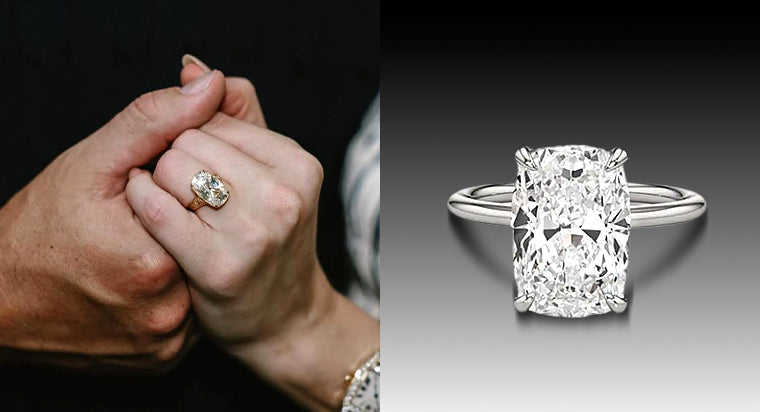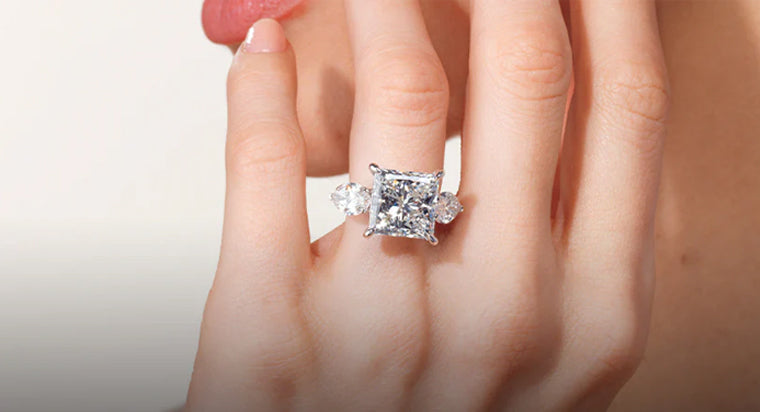What Is the 3 Months’ Salary Engagement Ring Rule?

For many years, the “3 months’ salary rule” has been considered the golden benchmark for how much one should spend on an engagement ring. But in a world where couples split bills, share goals, and prioritize experiences as much as possessions—does this rule still hold up?
With evolving financial priorities, emerging alternate diamond options, and changing perspectives on relationships and finances, the answer isn’t as clear. This blog breaks down the origin, evolution, and modern interpretation of the 3 months’ salary rule—so you can decide what’s right for you.
TABLE OF CONTENTS
Explanation of the 3 Months’ Salary Rule
So what in the world is the 3 month salary rule? In its simplest form, the rule suggests spending the equivalent of three months of your income on an engagement ring.
For example:
- If you make $45,000 per year, (or about $3,750 per month) three months’ salary equals to $11,250
- If you earn $60,000 per year, (or about $5000 per month) three months’ salary equals $15,000
It’s a straightforward formula, tying the ring budget directly to income.
The Origin of the 3 Months’ Salary Rule
The 3 month salary rule was not born out of tradition or romance. It actually came from a marketing campaign that the diamond company De Beers created to increase diamond sales.
In the 1930s, the campaign started with suggesting that a man should spend one month’s salary on an engagement ring. After World War II, this shifted into the two months’ and by the 1980s, it had climbed to three months, positioning the diamond engagement ring as both a symbol of love and a luxury investment. Pretty clever campaign, right?
And the message worked brilliantly. Movies, ads, and magazines reinforced the idea until it became ingrained in modern culture. What started as clever marketing turned into a social norm.
Should You Spend 3 Months’ Salary on an Engagement Ring?
The 3 months’ salary rule was once a popular guideline, created to encourage higher spending on diamond rings, not based on any genuine tradition or etiquette. It doesn’t reflect modern financial priorities, cultural shifts or relationship dynamics.
Today’s couples are approaching engagement ring purchases differently. Instead of blindly following the age-old rule, they’re adopting a more practical approach, accounting for finances (saving goals, debt, living expenses etc) and personal values. The “average” engagement-ring spend today is far lower than three months’ salary; what’s meaningful and comfortable differs widely.
However, some couples who are unsure where to begin, still find this guideline helpful even today because it gives them a clear-cut number and eliminates the guesswork. The salary rule also highlights a desire to express commitment to your partner through a substantial investment.
Ultimately, it all depends on ‘YOU’. There’s no single “right” amount you should spend on an engagement ring. It depends entirely on your personal values, income, savings, lifestyle, and priorities as a couple.
How to Determine Your Engagement Ring Budget
Instead of following a fixed rule to determine your ring budget, use these factors to guide your decision:
- ● Financial Health: Consider income, savings, and upcoming expenses.
- ● Lifestyle & Priorities: Consider the importance of the ring in relation to your other financial goals. Maybe you’re saving for a house, an epic trip, or a future family.
- ● Partner Preferences: While some might want a modest solitaire, another could prefer a statement engagement ring. Everyone has different tastes!
- ● Long-Term Perspective: Engagement rings are worn daily for decades. You’ll want to choose quality over a price tag so that it’ll last.
Pro Tip: To get a stunning ring and not spend as much, consider a lab grown diamond engagement ring. Lab-grown diamonds offer up to 40% more value, allowing you to maximize size and quality without blowing your budget.
The Role of Lab-Grown Diamonds in Rethinking Budgets
The rise of lab-grown diamonds has completely changed how modern couples approach engagement ring shopping.
These diamonds are chemically and visually identical to mined ones but often cost 30–40% less. That means you can get a larger carat, better clarity, or a more intricate setting—all within your budget.
Opting for lab-created diamonds empowers buyers to prioritize beauty and value over rules created by marketing campaigns. Plus, lab diamonds have some extra benefits like being sustainable and ethically sourced. Brands like With Clarity offer ethically-sourced, certified lab diamonds at every price point.
Lab-grown Diamond Engagement Rings at With Clarity
At With Clarity, we believe your engagement ring should be a reflection of you—not a rulebook, which is why we offer lab diamond engagement rings for every style and budget. From timeless solitaires to modern halos, our designs cater to every aesthetic and price range.
Lab diamonds are available in all shapes and carat weight so you have plenty of options.
We also allow you to personalize every detail and even custom create your lab diamond engagement rings so you end up with a ring that tells your story.
From guiding through the designing process to answering any questions that you have about diamonds or engagement rings, our in-house team of jewelry experts are always there. They’ll work with you to find a perfect ring that fits your style and budget. Because we don’t just want you to buy a ring, we want you to enjoy the jewelry-buying process.
Conclusion
For decades, the “3 months’ salary rule” has been a common guideline for how much to spend on an engagement ring. But today’s couples are choosing to make their own engagement ring rules based on what feels authentic to them. Whether that means splurging on a statement piece or opting for a sustainable lab-grown diamond, what matters most is the love it represents.
FAQs
Is the 3 months’ salary rule mandatory?
How much do most people spend today?
Can I get a quality ring for less?
Are lab-grown diamonds a smart way to save?
How can I decide on a ring budget with my partner?









